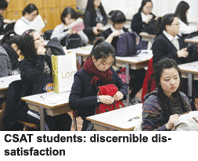People reach for extremes when discussing education’s hold on South Korea’s collective psyche and its shaping of society.
 The statistics for higher education tell a remarkable story. At 53 percent, South Korea has the highest proportion of graduates among 25-34-year-olds of any nation in the Organisation for Economic Cooperation and Development (OECD), according to 2008 figures. That compares with 38 percent for the UK and 42 percent for the US. By 2025, about 80 percent of South Korean 25-44-year-olds will have participated in higher education, the OECD forecasts, the highest percentage worldwide.
The statistics for higher education tell a remarkable story. At 53 percent, South Korea has the highest proportion of graduates among 25-34-year-olds of any nation in the Organisation for Economic Cooperation and Development (OECD), according to 2008 figures. That compares with 38 percent for the UK and 42 percent for the US. By 2025, about 80 percent of South Korean 25-44-year-olds will have participated in higher education, the OECD forecasts, the highest percentage worldwide.
This nation of 49 million people has 211 colleges and universities, with junior colleges, education colleges and graduate institutions taking the tally of higher education institutions to 406. By comparison, the UK with a population of nearly 62 million hosts 165 higher education institutions.
But what is the cost of this fervour for higher education? Many observers argue that South Korea’s universities drive its hierarchical society. Some say the country has gone too far in its enthusiasm for higher education, and that its university system plays too large a role in cementing social divisions rather than imparting knowledge. Competition for places at the best universities is so intense, others claim, that people are put off having children because of the high cost of getting them into higher education institutions. Ha-Joon Chang, reader in the political economy of development at the University of Cambridge and author of 23 Things They Don’t Tell You about Capitalism, says that at one level, the South Korean attitude to higher education “is a great success story; at another it’s pathological”.
The question is, then, at what point does the insatiable appetite for higher education in South Korea become counterproductive — and what lessons other nations can take from its experience? Aidan Foster-Carter, honorary senior research fellow in sociology and modern Korea at the University of Leeds, says that from the beginning of the independent republic of Korea (1945), there was “a mania for education” that led to a significant expansion of the university sector.
Entry to universities is determined through the mainly multiple-choice College Scholastic Ability Test (CSAT), although the government is aiming to reduce the role of the exam in admissions. Students are under intense pressure as they prepare for the exam. Such is the societal importance of the CSAT that there are stories of police clearing traffic to ensure that students reach the exam room on time. Fierce competition has forced parents to hire private tutors to give their children the best chance of success in CSAT.
Yet despite South Korea’s educational achievements, there is a discernible mood of dissatisfaction in its universities. Some point to the number of young people choosing to leave the country to study abroad as a sign that something is wrong. After China and India, South Korea is the biggest exporter of students, with 105,327 of them studying abroad, according to 2009 figures.
Alongside the soaring enrolment rate and thirst for higher education, the desire to compete internationally is a defining characteristic of South Korea’s universities. Asked why the nation’s institutions are so keen to win global recognition, Byoung-Joo Kim, adjunct professor at Ehwa Women’s University, describes that as a “strange question to a Korean”. “We’re used to moving up continually,” he says. “From the poorest country in 1950, to one of the top 10 economies now — we only know the way up. We always want to be at the top. It’s embedded in our culture: the competition, the competitiveness.”
(Excerpted and adapted from Times Higher Education)